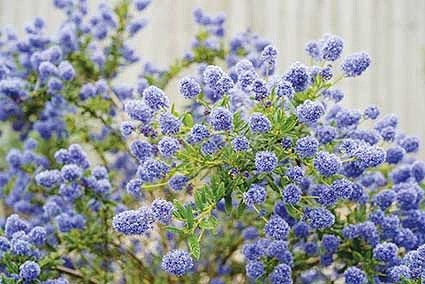
Gardening Journal: Plant of The Month – Ceanothus Concha
April is always the month I feel we leave winter behind us. Lawns need to be mown and weeds start to grow - It’s a great time of year as the garden wakes up and we can get on with my favourite of all gardening jobs – planting!Spring is the best time of year for planting, with plenty of moisture left in the soil, providing ideal conditions for establishing the roots of newly planted plants. Now is the time to pop out to the nursery and get that plant you have always wanted to include in your garden and get it in the ground – better than planting in the dry barren soils of the summer!
California lilacs (Ceanothus) are well-known for the masses of intensely blue flowers produced in April, May and June. A good blue is a rare commodity in the garden, which is why California lilacs are so prized.
North and Central America have 55 different ceanothus but the most spectacular, bright-flowered, evergreen species grow close to the sea in California, high up in the scrubby chaparral.
Used in early American gardens, they first came to Britain from France when the famous Hackney nursery, Loddiges, imported C. azureus from Empress Josephine's Malmaison garden.
The intense blue flower of Ceanothus 'Concha' is heightened by a backdrop of crisp, dark evergreen leaves. It was originally found in a Welsh garden in Nantyderry and won an AGM in June 1986. It’s a great plant for a wildlife garden, as it will attract bees, butterflies and other pollinators. Plus, with the right variety and training, they can form a floriferous and highly attractive small tree.
Evergreen ceanothus vary in habit from the lanky, tree-sized C. arboreus, commonly called the Catalina Mountain Lilac, to the dense, mound-forming C. thyrsiflorus var. repens from California and south Oregon. They tend to be short-lived, succumbing in really hard winters and need to be trained against a warm wall. In Britain 'Concha' is one of the few varieties that is hardy to -10°C and looks far more impressive as a specimen shrub, with its arching branches.
Ideally gardeners should emulate the drier sunnier conditions in native California for ceanothus to really work well. They prefer good drainage and a sheltered position and are happy in free-draining alkaline or acid soils away from chalk and wet clay - though drainage can be improved by adding coarse grit to the ground.
I’m a big fan of the blue and lime green combination and my favourite plant to accompany ceanothus would definitely be a euphorbia of some kind. If you have space then maybe Euphorbia characias Wulfenii, if space is a little restrictive then Euphorbia x martini. The yellow of Anthemis tinctoria 'E C Buxton', and Phlomis russeliana also look good and they all prefer the same drier conditions too.
Jobs to be doing this month include:
Ornamental Garden:
• Continue to remove faded flowers on spring bulbs but not the foliage until it is withered.
• Keep borders weed free.
• Mulch borders if not completed last month.
• If the weather is mild then trim weak or straggly growth of sage and rosemary.
• Penstemons – Cutback last years stems down to the new growth – if the weather is very cold delay until end of the month.
• Check evergreens for any frost damage – lightly prune if necessary.
• Look out for early aphid attacks and treat if necessary.
• Sweet Peas can be direct sown now to produce plants that flower later than those sown under glass or over wintered plants.
• Prune early flowering shrubs such as forsythia etc.
• To ensure strong growth on roses apply general fertiliser.
• Plant evergreen trees and shrubs/move existing evergreens if necessary.
• Trim back frost damaged foliage.
• Plant summer fruiting corms and tuberous plants including dahlia, gladioli and canna.
• Apply combined feed, with moss and weedkiller to lawns if necessary.
Vegetable Garden:
• Continue planting potatoes and finish planting onion setts by mid April.
• Direct sow vegetables such as beetroot, carrots, lettuce, radish, turnip, peas, spinach and parsnip.
• Prune young stone fruit trees such as cherries and plums as leaf buds open.

